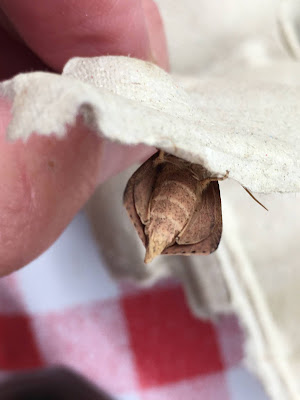Another newcomer for my list today: as soon as I saw this beige-y wainscot at the very end of my trawl through the eggboxes, I thought: 'Mmmm. Don't think I've seen that before.' Sure enough, it is a Webb's Wainscot, an attractive member of that large tribe and still ranked Nationally Scare although it seems to be on the increase.
 It was first described as long ago as 1790 by a Bavarian naturalist Eugenius Johann Christoph Esper who was encouraged by his botany professor at the university of Erlangen to abandon his original course which was in theology. Who knows what he might have achieved in the church, but he certainly did a lot of excellent work on butterflies and moths including several books whose value and relevance has lasted.
It was first described as long ago as 1790 by a Bavarian naturalist Eugenius Johann Christoph Esper who was encouraged by his botany professor at the university of Erlangen to abandon his original course which was in theology. Who knows what he might have achieved in the church, but he certainly did a lot of excellent work on butterflies and moths including several books whose value and relevance has lasted.It might therefore be called more justly Esper's Wainscot but Mr Webb took the honours when it was first discovered in the UK, in Kent in 1879. It is noted for the very widely scattered range of sightings, reaching as far north as Spurn point in Yorkshire and Tynemouth near Newcastle upon Tyne, but only in very small numbers and not yet as colonies. More recent successes have come further south including round here.
Here it is, above, with a similarly beige form of the Common Wainscot and below a view of its slender, cone-like abdomen from behind. Thank you for paying me a call and adding to my ever-growing list.
In other parts of the trap and its surroundings, the guest list continues at a high occupancy rate. Every morning, there are Brimstones in the grass around the trap and yesterday they were joined by this Poplar Hawk, a moth which is enjoying a very long season this year.
The macro moths furnished my first Shaded Broad-bar of the year as well as a very battered Black Arches whose apparently full life hadn't affected its liveliness and flying skills,

Neighbours who came to see the moth trap recently and remarked on the beauty of some White Ermines WhatsApped me this photo of a caterpillar they found and were startled to be told that it will turn into..a White Ermine. How a hairy black beastlet can metamorphose into the lovely white adult with its black dots like the fur collar of a member of the House of Lords is one of the many, many wonders of Nature.
Then this morning, as we were having breakfast outside, a bright flutter of red followed by a large, dark triangle on a sunny wall indicated the presence of a Red or - hope against hope - a Dark Crimson Underwing. Both are regular dayflyers and this one proved to be Red. Common but delectable, like the one in the moth trap earlier this week.
Finally, I was delighted to discover these stained glass butterflies in the little church at Wytham, near Oxford where the wonderfully wooded estate was given to Oxford University after the Second World War by Colonel and Mrs ffennel whose forebears the windows commemorate. You can read the story of this remarkable couple here on the website of the Open Air School they founded to give children from towns and cities some experience of the countryside. A touching quite from a little girl pupil in a letter home is 'This must be a very holy place'. Another example of how nature in the hands of people like the ffennels and Herr Esper of Webb's Wainscot can do us all a power of good.















No comments:
Post a Comment